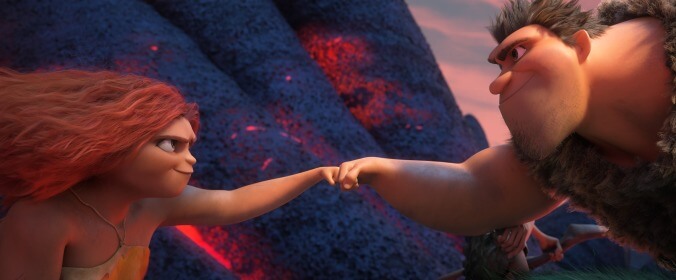An unnecessary sequel to The Croods still has some prehistoric fun

Note: The writer of this review watched The Croods: A New Age on a digital screener from home. Before making the decision to see it—or any other film—in a movie theater, please consider the health risks involved. Here’s an interview on the matter with scientific experts.
DreamWorks Animation has a knack for knocking off its competitors, whether by subterfuge or coincidence. So it would be easy enough to say that its 2013 cave-people family comedy The Croods barely evolved from an unholy offspring of Ice Age’s perpetual epoch-shifting and Hotel Transylvania’s overprotective-father anxieties. (Aardman’s similarly themed Early Man came later on; stop-motion takes even longer than cave drawings.) But Croods boasted a secret weapon in the form of director Chris Sanders. His single Disney film, Lilo & Stitch, gave him ample practice sidestepping the worst habits of animation conglomerates, something he put to good use on The Croods.
Sanders is conspicuously absent from the belated and once-canceled sequel The Croods: A New Age, and he leaves in his wake a frenzy of what’s distinct about the first movie and what sucks about many of its DreamWorks cousins. In the opening 10 minutes alone, there’s pointless elaboration on an established character’s backstory; redundant hey-that’s-me expositional narration; cheesy speed-ramping in an opening action sequence; and, more happily, a spectacularly animated, inventively edited frolic through a series of fantastically loopy prehistoric landscapes.
The frolickers in question are cave-girl Eep (Emma Stone) and her more technically evolved paramour, Guy (Ryan Reynolds), who met in the first film. Their mutual crush has since blossomed into full-on teenage romance, much to the chagrin of Eep’s father, Grug (Nicolas Cage), who has grown to enjoy his family’s nomadic, pile-sleeping lifestyle of dodging predators and foraging for food—or at least, he fears that Eep will abandon it (and him). The whole family—including Grug’s wife Ugga (Catherine Keener), son Thunk (Clark Duke), feral baby Sandy (Kailey Crawford), and matriarch Gran (Cloris Leachman)—eventually stumbles upon a lush farm estate with ample food and technological conveniences such as beds, run by an upright, sandal-wearing clan calling themselves the Bettermans. Phil (Peter Dinklage), Hope (Leslie Mann), and their daughter Dawn (Kelly Marie Tran) are delighted to see Guy, if politely wary of the rest. Eep and Grug are more suspicious of this potential new living arrangement for different, sometimes oppositional reasons.
With eleven different characters to serve—not counting several animal sidekicks—A New Age has a lot going on in terms of plot and action, with a litany of new alliances, betrayals, and team-ups. But the sequel is not as visually sophisticated as its predecessor. Though it came off the DreamWorks assembly line, the first Croods had some distinctive virtual camera work, simulating longer, handheld takes and low-angle shots to give its world both an expansiveness and a jittery immediacy. A New Age uses more cartoon-typical cutting and occasional long shots, almost all in service of either gags or the kind of high-octane action that’s become obligatory in even the most kid-friendly American animation.
What the sequel retains is Sanders’ visual template of a surreal land saturated with bright colors and perversely hybrid creatures—like Trolls without the relentless dance parties. Purely on a design level, A New Age might be even weirder than its predecessor. It’s definitely sillier, and with that comes certain freedoms, especially in the vocal performances: Cage is Cage-ier, whether he’s wistfully reminiscing about a time he ate a banana or screaming at his family to shut up, and Emma Stone’s expressive tones are a big part of what makes Eep such an endearing heroine. She hasn’t lost her scrappy, gnarly athleticism, and neither has the movie. Though the sequel is gag-heavier, the hit rate remains relatively high and the pop-culture references low.
New director Joel Crawford (a veteran story artist directing his first feature) doesn’t have the willpower to resist other DreamWorks standbys like cheesy, jokey music cues—though when one of the most prominent is an original song from HAIM, who can blame him? (A couple more strong soundtrack cuts involving the Kung Fu Panda himself, Jack Black, are unfortunately relegated to the closing credits.) A bigger problem, at least for adults in the audience, is how the movie’s cleverness flags as it goes on. The parenting story and any social satire are muddled, too, the younger characters’ storylines forever crowded out for another round of dads learning to let go. That The Croods: A New Age is both entertaining and utterly superfluous does feel like a sort of evolution for DreamWorks Animation: They’ve got nothing left to knock off but themselves.